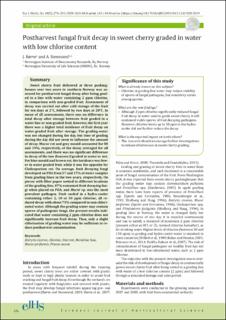| dc.description.abstract | Sweet cherry fruit delivered at three packinghouses over two years in southern Norway was assessed for postharvest fungal decay after being graded in a line with water containing 2 ppm chlorine, in comparison with non-graded fruit. Assessment of decay was carried out after cold storage of the fruit for ten days at 2°C, followed by two days at 20°C. In mean of all assessments, there was no difference in total decay after storage between fruit graded in a water line or non-graded fruit, however, the first year there was a higher total incidence of fruit decay on water-graded fruit after storage. The grading-water was not changed during the day, but time of grading during the day did not seem to influence the amount of decay. Mucor rot and grey mould accounted for 80 and 19%, respectively, of the decay averaged for all assessments, and there was no significant difference in decay of the two diseases if graded in water or not. For blue mould and brown rot, the incidence was lower in water graded fruit, while it was the opposite for Cladosporium rot. On average, fruit decaying fungi developed on PDA from 57 and 17% of water samples from grading lines in the two years, respectively. On pieces with filter paper wetted in different locations of the grading line, 87% contained fruit decaying fungi when placed on PDA, and Mucor sp. was the most prevalent pathogen. Fruit cooled in a hydro-cooler containing either 2, 10 or 50 ppm chlorine, all reduced decay with about 75% compared to non-chlorinated water. Although the grading water may contain spores of pathogenic fungi, the present results indicated that water containing 2 ppm chlorine does not significantly increase fruit decay. Thus, only a slight chlorination of grading water may be sufficient to reduce postharvest contamination. | |
